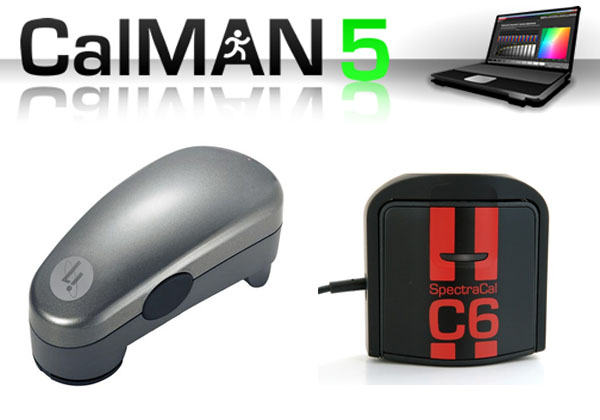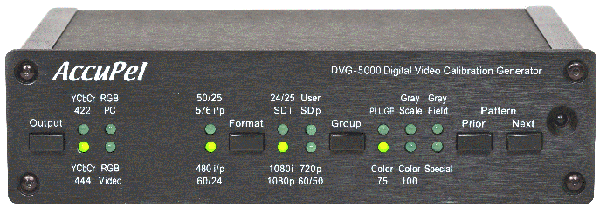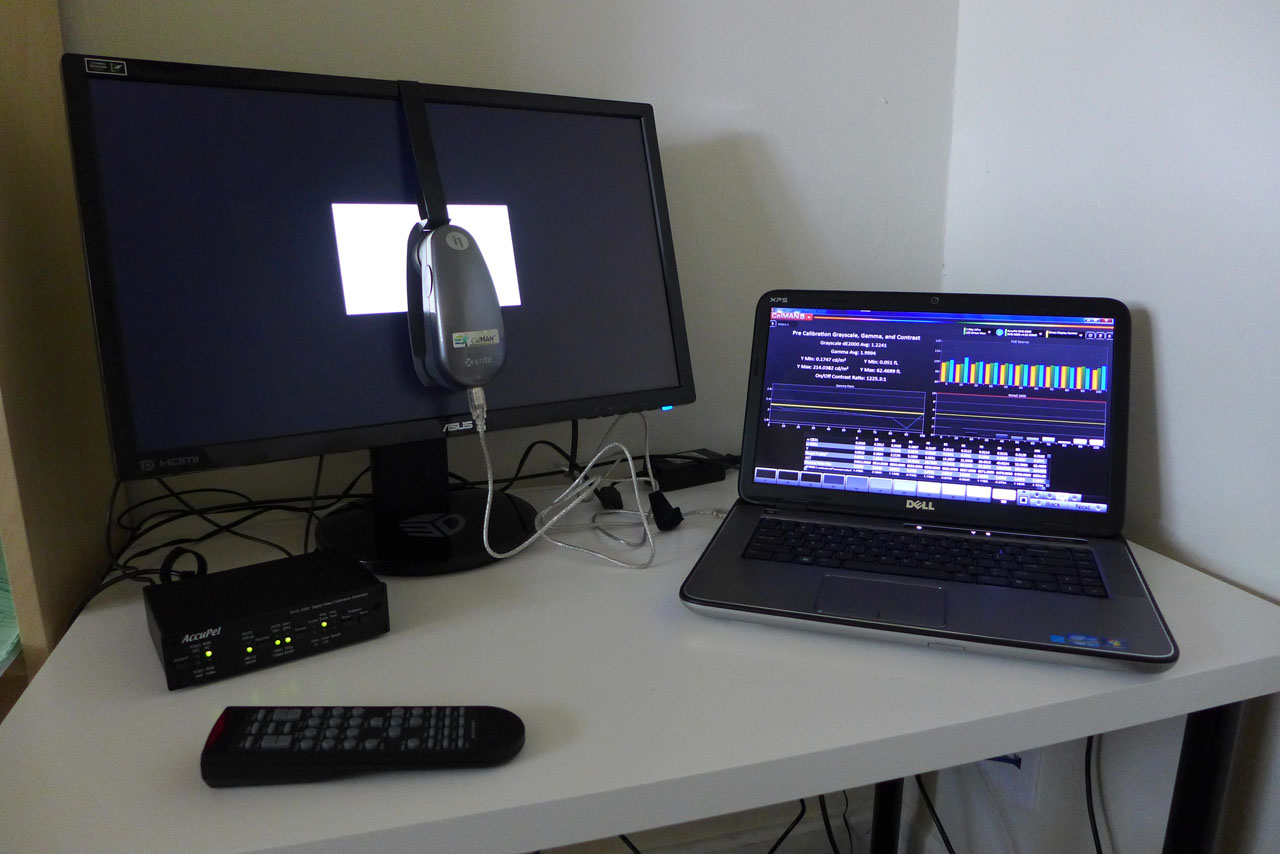BenQ RL2460HT 24-Inch Monitor Review: Is Gaming Good At 60 Hz?
Does a true gaming monitor need to have a 120 or 144 Hz refresh rate? BenQ’s RL2460HT offers plenty of features that cater to enthusiasts, but it tops out at 60 Hz. Can those extra capabilities compensate, or should you continue your search elsewhere?
Measurement And Calibration Methodology: How We Test
To measure and calibrate monitors, we use an i1Pro spectrophotometer, a Spectracal C6 colorimeter, and version 5.2.0.1374 of SpectraCal’s CalMAN software.
The i1Pro is very accurate and consistent measuring color on all types of displays, regardless of the backlight technology used. When we just need a luminance value, the C6 works better, especially in low light.
For patterns, we employ an AccuPel DVG-5000 video signal generator. This approach removes video cards and drivers from the signal chain, allowing the display to receive true reference patterns. Connections are made via HDMI.
The AccuPel DVG-5000 is capable of generating all types of video signals at any resolution and refresh rate up to 1920x1080 at 60 Hz. It can also display motion patterns to evaluate a monitor's video processing capabilities, with 3D patterns available in every format. This allows us to measure color and grayscale performance, crosstalk, and ghosting in 3D content via the 3D glasses.
The i1Pro or C6 is placed at the center of the screen (unless we’re measuring uniformity) and sealed against it to block out any ambient light. The AccuPel pattern generator (bottom-left) is controlled via USB by CalMAN, which is running on the Dell XPS laptop on the right.
Our version of CalMAN Ultimate allows me to design all of the screens and workflows to best suit the purpose at hand. To that end, I’ve created a display review workflow from scratch. This way, we can be sure and collect all the necessary data with a concise and efficient set of measurements.
The charts show us the RGB levels, gamma response, and Delta E error for every brightness point from zero to 100 percent. The table shows us the raw data for each measurement. And the area in the upper-left tells us luminance, average gamma, Delta E, and contrast ratio. The individual charts can be copied to the Windows clipboard to easily create graphics for our reviews.
Get Tom's Hardware's best news and in-depth reviews, straight to your inbox.
Every primary and secondary color is measured at 20-, 40-, 60-, 80-, and 100-percent saturation. The color saturation level is simply the distance from the white point on the CIE chart. You can see the targets moving out from white in a straight line. The further a point is from center, the greater the saturation until you hit 100 percent at the edge of the gamut triangle. This shows us the display’s response at a cross-section of color points. Many monitors score well when only the 100-percent saturations are measured. Hitting the targets at the lower saturations is more difficult, and factors into our average Delta E value (which explains why our Delta E values are sometimes higher than those reported by other publications).
Current page: Measurement And Calibration Methodology: How We Test
Prev Page OSD Setup And Calibration Of The BenQ RL2460HT Next Page Results: Brightness And Contrast
Christian Eberle is a Contributing Editor for Tom's Hardware US. He's a veteran reviewer of A/V equipment, specializing in monitors. Christian began his obsession with tech when he built his first PC in 1991, a 286 running DOS 3.0 at a blazing 12MHz. In 2006, he undertook training from the Imaging Science Foundation in video calibration and testing and thus started a passion for precise imaging that persists to this day. He is also a professional musician with a degree from the New England Conservatory as a classical bassoonist which he used to good effect as a performer with the West Point Army Band from 1987 to 2013. He enjoys watching movies and listening to high-end audio in his custom-built home theater and can be seen riding trails near his home on a race-ready ICE VTX recumbent trike. Christian enjoys the endless summer in Florida where he lives with his wife and Chihuahua and plays with orchestras around the state.
-
eldragon0 ReplyDoes it even matter when games automatically enable Vsync setting to 60 Hz?
No, but chances are if you're dropping 300+ on a monitor and genuinely want the extra frame rate you will be the type of person who is ready and expecting to tweak the game's files to run at those frame-rates. -
eldragon0 ReplyDoes it even matter when games automatically enable Vsync setting to 60 Hz?
No, but chances are if you're dropping 300+ on a monitor and genuinely want the extra frame rate you will be the type of person who is ready and expecting to tweak the game's files to run at those frame-rates. -
Heironious Yes, it matters. After buying the ASUS VG248 with Lightboost enabled in 2D gaming, I can not go back to a 60hz monitor. Is it really that hard for you to disable Vsync in the games settings?Reply -
envy14tpe I think most mid-range gamers go 60Hz TN panel monitors that sell for $150 or less. This monitor seems pretty pricey and is stuck between those and the 144Hz monitors. I don't' think this will sell all that well.Reply -
therogerwilco The ZR30W is 2560x1600, yet only 60 hz.Reply
I achieve first place in multiple games when playing multiplayer, on a regular basis.
60hz is not the problem, the problem is your system if it CAN'T sustain 60 fps. -
Xivilain If your monitor supports 30hz, 60hz, or even 120hz, its nice to see the visual difference they make when compared side by side. I like to show other people this demo to compare FPS:Reply
http://frames-per-second.appspot.com/ -
xenol When frame rate time periods start exceeding the fastest reaction times of humans, I start to question whether or not even faster frame rates are necessary.Reply
I don't think competitive players win because they have 144Hz monitors and can react with all that information being fed to them. I think they win because they are proactive, and that there are many tells anyway to allow someone who's tuned in the game to react quickly.
I mean, StarCraft has choppy animation that is independent of refresh rates (they look like they move at 20FPS), but there's a lot of high level competition there. -
heydan Im still don´t know how people reach the 120-144 fps in any game even at 1080p, maybe they refer to fps higher than 60fps, like 70, 80, and maybe for some old games the 120-144 fps, or they play games with low settings in order to reach those fps?, can someone explain me?, because I can find any review about any high end GPU and found that there´s so little games that achieve 120-144 fps at 1080p with everything max out...Reply -
tipmen ReplyIm still don´t know how people reach the 120-144 fps in any game even at 1080p, maybe they refer to fps higher than 60fps, like 70, 80, and maybe for some old games the 120-144 fps, or they play games with low settings in order to reach those fps?, can someone explain me?, because I can find any review about any high end GPU and found that there´s so little games that achieve 120-144 fps at 1080p with everything max out...
You do have a point with newer games that have very nice graphics. Such as, BF, Metro LL, and Arma 3 you need a beefy GPU set up or some people turn down the settings. (Eye candy is nice but if it is going to be a slideshow it isn't worth it) However, older titles such as CS GO where having the higher FPS will give you an edge doesn't take much to get 200+ FPS. Basically computers with at least an i5 and a 6970 or 580 can hit FPS 100+ on older titles. Newer titles i5/i7 (depends on the game if it take advantage of the hyper threading) 7970(280)/290x or 680/780. Crossfire or SLI helps but I personally find the gaming experience smoother playing CS GO on one 7970 instead of two in crossfire. With one I am still well over 100 FPS. When I play BF4 I have crossfire enable and high settings with some things turned down I get over 100FPS on DX11 API. When I try mantle (When it works....) I get an extra 10fps if I am lucky and feels smoother. You also can check Toms GPU charts of even their recently released SMB. I own Asus 144hz and never can go back to playing FPS on something less. I just wish they will catch up to my golden days with the CRTs refresh rates .




